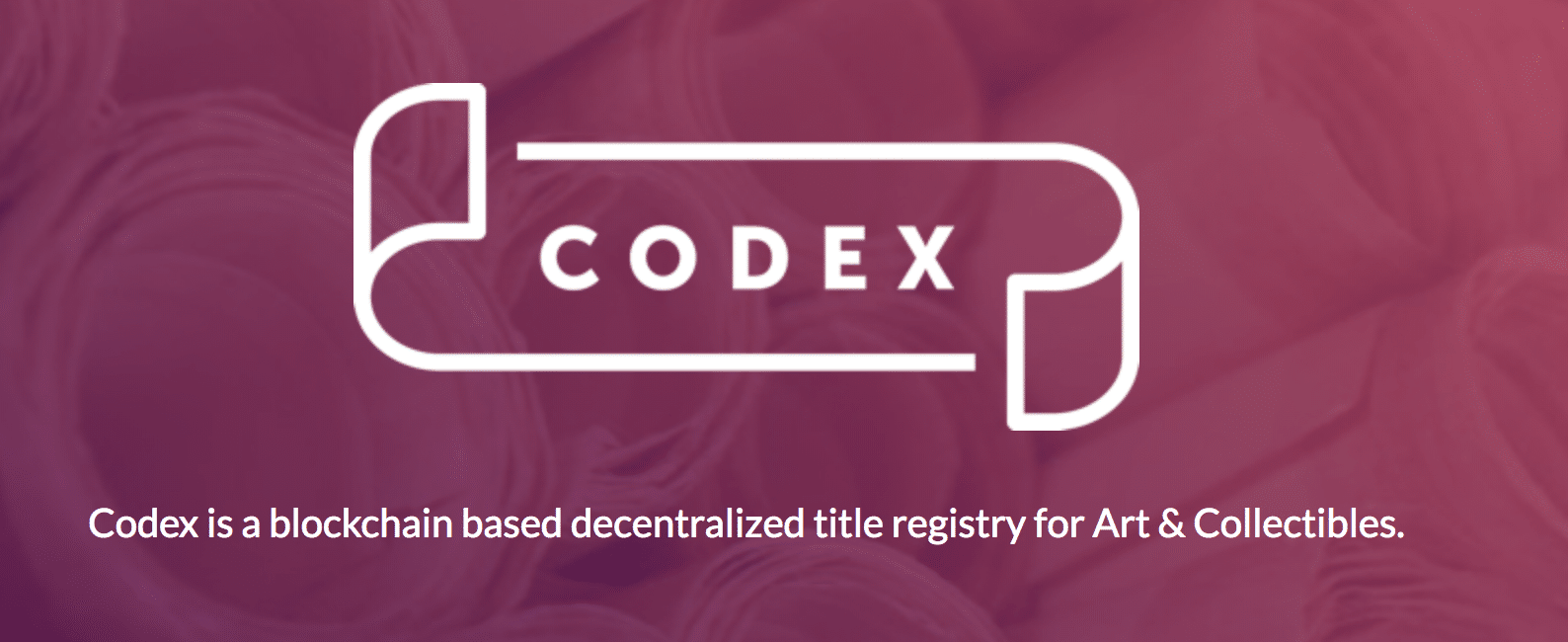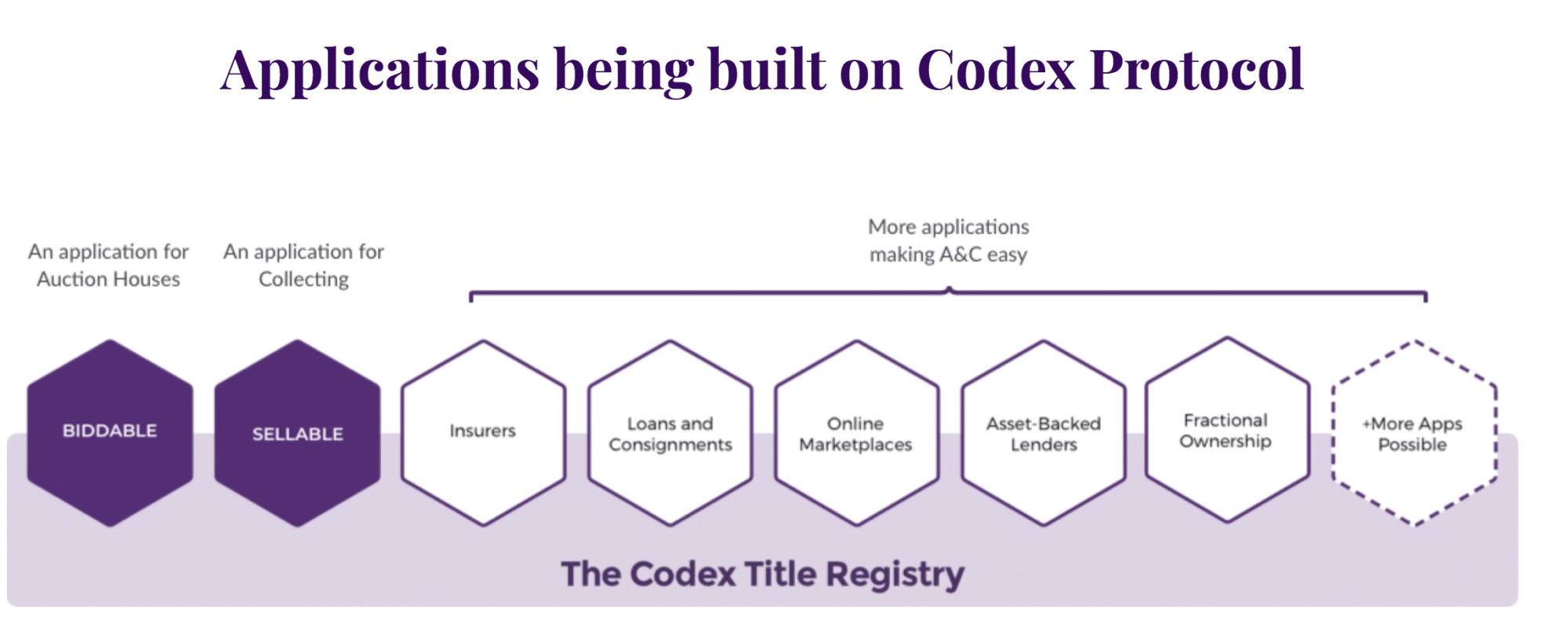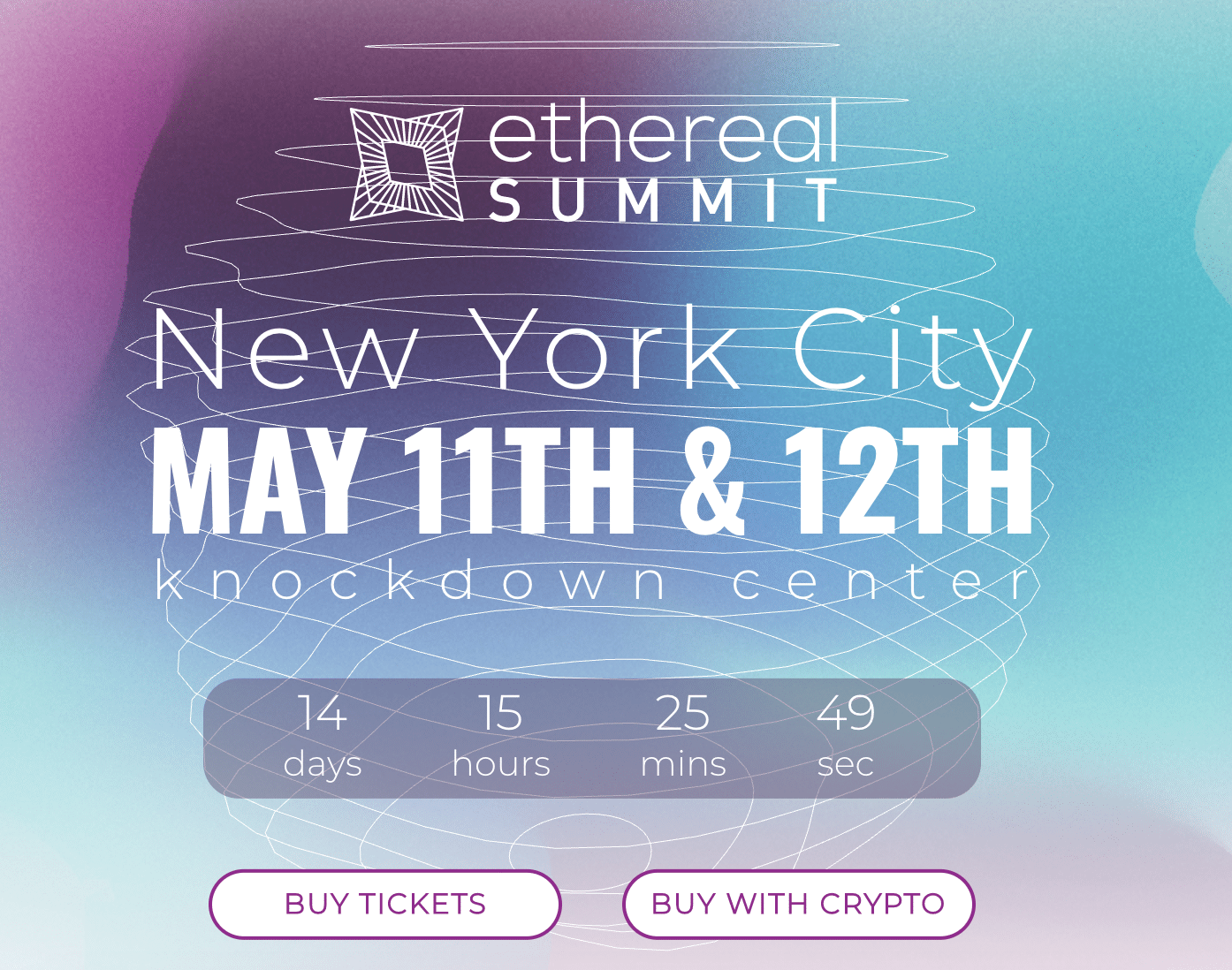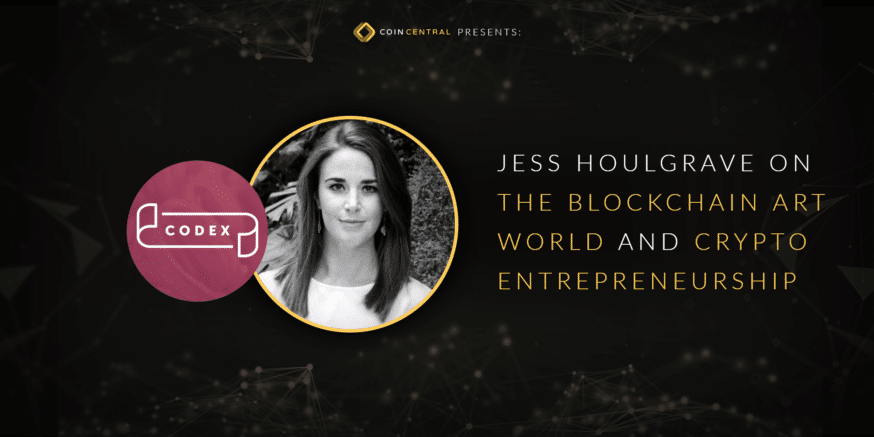Codex Protocol’s Jess Houlgrave on the Blockchain Art World and Crypto Entrepreneurship
 The Codex Protocol is a decentralized title registry for the art and collectibles industry. As one of the few early functioning art blockchain projects, the Codex Protocol is an interesting project to follow for entrepreneurs, blockchain aficionados, and the art community at large.
The Codex Protocol is a decentralized title registry for the art and collectibles industry. As one of the few early functioning art blockchain projects, the Codex Protocol is an interesting project to follow for entrepreneurs, blockchain aficionados, and the art community at large.
DApps on the Codex Protocol will also allow art collectors to easily find what type of art they want and purchase art at auctions.
At launch, several initial DApps will allow collectors to more easily find what they want, and buy at auctions with cryptocurrency.
Jess Houlgrave is the Co-founder & COO at Codex Protocol and borrows from her experiences in everything from spending a few years in the finance industry and being a blockchain and art consultant.
Can you tell us a little bit about Codex and what you guys are looking to solve?
Codex is a decentralized title registry for the $2,000,000,000,000 art and collectables asset class. It’s an asset class where the primary value driver is provenance, and by that, we mean the history of the item, who’s owned it, whether or not it is authentic, which institutions have handled it. All of these things which create the identity and the history of the object and hold its value. It’s also the key pain point in the ecosystem.

So, many of the challenges, whether that’s high commission prices, challenges with getting insurance, an absence of asset-backed lending, all of those sorts of perceived issues. Many of them, the root cause of them is typically that providence is hard to find and verify.
So, by bringing that information onto the blockchain, we can allow people to hold it in a secure private way, but also in a way that makes it easy to share with the relevant parties and to verify, which should eliminate some of those frictions within the ecosystem that we see today.
Provenance has been a huge issue in everything. Not even just the art world. Things like fake wines to any sort of fake collectible item. I think blockchain has a lot of potential to solve those issues.
If you understand some of those problems and you understand blockchain technology, it’s almost a kind of an obvious solution. I’m creating something that can solve some of those issues. It’s a great use case for the technology.
How does the Codex protocol work exactly?
I can give you some of it. If you have specific technical questions, they’re probably best handled by our CTO. At a high level, essentially, we use non-fungible tokens. We’re built on the Ethereum platform.
We use non-fungible tokens, ERC721, as a kind of digital identifier, the identity of each item. To that, we can hash metadata, whether that’s images of the item, copies of receipts, transaction records, appraisal documentation. All of that is stored in a secure way so that it’s not visible. People can’t see the data about your items, but they are held in a way that is easily verifiable by people.
 cons
cons
Essentially, that functions as an infrastructure layer on top of which we can build different applications. So, the first application we’ve built is one Biddable. It’s designed for the auction industry and we have built a consortium of software providers in the auction space. It will enable instant registration for bidding using a deposit escrow system that we’ve built in the Biddable application.
Are you all planning to open up the protocol for other third parties to build on top of it as well, or will you guys be building everything internally?
We very much anticipate and want people to build on top of Codex. There are certain applications which we see as being very valuable for the ecosystem, so we think the applications for auction houses is a useful one. It drives fast adoption of the title registry. Many, many items pass through auction each year and enable the ecosystem to kind of get started.
There is an endless list of potential applications, some of which we have thought about and we’re really excited about and particularly interested in the asset-backed lending space, in the insurance space, in the appraisal space, but there are applications which could facilitate artists to manage the inventory in their studios.
Applications which would facilitate a collector just to manage their own inventory across various locations. So, we really hope and expect that third parties will build on top of Codex and that’s very much part of our plan is to bring on partners who can build and work within the Codex ecosystem.
I had no idea just how valuable blockchain could be in the art world and how many different things it touches within the art industry. It’s cool that you guys are kind of building that ecosystem.
Yeah, prior to founding Codex, I wrote a master’s thesis on the applications of blockchain for the art ecosystem. I spent a lot of time researching what the technology could mean for different stakeholders including insurers, auction houses, asset-backed lenders, shipping logistics companies.
All of these peripheral services which really actually are a very crucial part of the art and collectibles ecosystem. Through that approach, we realized that in order to be truly valuable, having some sort of proprietary register doesn’t really do the job and that building an ecosystem where anybody can participate, anybody can build an application that accesses the registry and then you achieve full interoperability from different parties within the ecosystem.
And that’s why this is really valuable. It saves people doing research and verification time and time again when it’s already been done in a way that is now verifiable thanks to the blockchain.
I was actually reading through some of your Medium articles before this. All very interesting stuff by the way, but I saw one that you talked about kind of the absence of shared research and knowledge specifically about blockchain within the art ecosystem. What do you think people can do within the industry to help get rid of that and help spread the word about blockchain within art?
Yeah, I think you’re right. It’s definitely a critical issue. When I wrote that blog post, it was really at the beginning of thinking about how to solve that issue. Part of what I am really keen to do is to make my research more publicly available because I think it’s a great entry point for people.
Many people have it and I really welcome if anybody is specifically interested in it to get in contact and I can share a copy with people. It’s not publicly published yet, although I think it will be soon. But more importantly, I think it’s beginning to educate yourselves. A lot of people within our ecosystem have an excellent knowledge of their business and of the art world, but blockchain is relatively new to them.
There are a ton of resources, like “Artnome” by Jason Bailey is a great blog which has tons of content about the impact of the blockchain on the art world. There are a few other academic papers and one thing that I really like is that more and more events are now covering this. The number of blockchain and art specific events or panels or conferences that I’ve been invited to have gone from zero when I first started thinking about this space to now sort of once a week.
I would really encourage anybody who works in the art world who’s interested to find an event that’s local that can help people sort of try and get up the curve. Of course, to get in contact with us. We have a ton of resources.
We’re really, really excited about this space and I think over the next several months, hopefully, we’ll be putting out lots of educational content which will help the art world to understand what blockchain is and what it means for them. So, if anybody’s interested, we’d really encourage them to reach out to us.
When talking with other people in the art world with blockchain being so young, do you get a lot of pushback? I know there’s a lot of stereotypes about blockchain and cryptocurrency, especially if you’re not involved in the industry. Or is it something once they realize how it can help our provenance and be valuable, does it click?
I’ve noticed a change over the last several months. Six months ago, when I was having discussions with people in the art world about blockchain, their first question was always isn’t Bitcoin just used for buying drugs on the Internet?
All of that sort of stereotypical reactions that people have. I think that is now changing a lot. There has been some great, great coverage in the art press about what blockchain is and what it could mean for people. I think we are now beginning to see people really kind of get interested in it.
I’m overwhelmed by the number of people we have contacting us at Codex who are auction houses, they are galleries, they are people with personal connections who are really just at the beginning of this journey but who want to find out more and they’re intrigued and excited about what blockchain could mean for them.
So, I think it’s seen a really positive shift. This kind of stereotype is beginning to clear. I think that leads the way for people to be very open-minded and very excited about the potential.
Take us into the mind of some of the mind of the CEO of a blockchain startup. What’s kind of like your day in the life?
A day in the life right now could be anywhere in the world in any time zone. I’ve been traveling a lot recently, we’ve been holding a private sale for Codex. And so, I’ve been traveling meeting investors. I have also had an amazing time over the last several weeks meeting new partners and these kinds of application builders and companies who are excited to engage with Codex as a title registry. That’s been extremely interesting for me, trying to learn what the pain points are in each of these businesses and to try to figure out ways that we can work together to solve them. On top of that, it’s a typical startup. It’s a fast-growing team. We’re spread around the world which adds an added layer of complexity, but it’s a great team. We’re growing, we’re really excited to welcome new people on board. The trials and tribulations of running a startup, but it’s all extremely exciting and we’re really pleased with the reception that we’ve had from people. I think people really get what we’re trying to do and that’s great.
I saw that your background was in finance and economics. Why the switch into art? What kind of prompted that?
I’ve been interested in art for a very long time, although professionally, my first degree is in economics and management. I then joined Credit Suisse and later managed a private equity portfolio for pension funds. My professional background is very finance orientated, but my personal passion is in the art world. I have a lot of friends who are artists and over the years, I’ve helped them with business decisions and I’m really very interested in how the art world works. I collect old maps so I’ve kind of come up against a lot of these problems of provenance and trying to find out the history and the value of items. So, it’s an area that has fascinated me for a very long time. It was an area that I had always thought about working in. In 2015, I went down the crypto rabbit hole as everybody says and was really spending a lot of time learning about the technology and what its potential applications where. I was very interested, of course, from a financial perspective, but actually, I was really excited by some of the kind of non-financial use cases. At the time, there were some very early things happening in the art well using blockchain. I spent a long time researching that and its applications. I worked at Southerby’s and simultaneously, did an MA in art business at Southerby’s Institute where I wrote my paper on the applications of blockchain for the art world. That was really my journey to get here.
Did you say you collect old maps?
It’s niche.
What’s the coolest map that you own? Do you have a favorite?
Yeah, there’s a map that I have which I’m just double checking the date on it now. It’s a 1720 map of the English Channel. I come from a family of sailors and it’s a very old map which shows all the seaports and navigation things in the Channel. That’s one of my favorites. It’s a niche collectible, but I’ve always amazed, particularly at blockchain conferences. You get chatting to somebody and find out that they collect watches or old maps or classic cars. It’s very interesting speaking with people to understand what they’re excited about.
Yeah, definitely. Any reason why maps?
I’m fascinated by them. I think that many of them are inherently beautiful and lovely to look at. But for me, it’s really about what they represent which is the frontier of human knowledge at a particular point in time. When these old cartographers were making their maps, they really were just piecing together all the available knowledge they had to make something which people actually were trying to use. They were using them to navigate or to just make political decisions or decide on expeditions. That’s kind of why I’m excited about them and interested in them and their history is because of kind of what it represents from the perspective of humans and human knowledge.
That’s cool. I never really thought about it that way but there really is like a sense of wonder and adventure. What are you most excited about in the art space or even in the blockchain space or the combination between them both?
One of the things that I’m most excited about at the intersection of the two is working with artists. It’s something that I’ve been doing for several years. I think artists have a really important role to play in the development of new technologies. I’m a believer that technology inherits the biases of the people who built it and I think that diversity, both in terms of background and context but also in terms of opinion, is really important when we’re developing new technologies. Artists very often can bring a totally different perspective to the table that nobody else has. I think it’s really important to engage them with this technology.
They have the position to be able to criticize it, to critically assess what it means for us as people. I am endlessly amazed by the works that artists that I know well who work in this space produce and I think that they play a huge role and also disseminating information about the technology to the wider public. It’s something that people can access and that can help people who are unfamiliar with blockchain have a tangible reference point to begin to start engaging with it. I’m very passionate about encouraging and supporting artists who work at the confluence of those two things.

We are launching our own blockchain foundation. The Ethereal Codex Rare Art Labs Auction, which is taking place at the Ethereal summit this year. All the proceeds from that will go to the foundation and that foundation will be used to support and help artists who are working in this space to fund artworks, events, education programs. I’m really, really passionate about getting more artists involved.
I’m thinking of executives and entrepreneurs that want to jump into the blockchain space, but they feel like a certain level of apprehension. It looks like your background was primarily in economics and finance. Why the switch to art and blockchain and what were some difficulties involved with the career switch?
I touched on the reason for doing it before. When I was learning about the technology, I just was overwhelmed by how many possibilities there were and how exciting this was and how revolutionary I think it can be for so many different industries. For me, art is a huge passion. I think the blockchain is particularly relevant for the art world.
There are a lot of issues which can be solved by using blockchain, and so that’s why I wanted to work in this space. In terms of anybody who’s thinking about this space, it’s extremely new. It’s certainly not without its risks. But we’re at this really unique moment, I think, which comes around once in a lifetime where there is this technology that’s being built that has really, really transformational potential. I’m just really excited to be a part of that.
It looks like you guys are already active and it’s awesome to see platforms that are already active. It’s on your site that says there are over 10,000,000 items sold annually with $6,000,000,000 in annual sales. Those are your figures, correct?
Yeah. In this space, it’s really crucial to get adoption and to build a product and a platform. There are a lot of projects that aren’t doing it and we’re extremely focused on really building stuff that is useful for the ecosystem. And so, the way that we do that is to bring partners into our consortium whom we can solve specific and real problems so that we’re actually using the software in a way that’s constructive.

For our first application, we are working with Live Auctioneers and Auction Mobility who are our two founding consortium members. They’re software providers to the auction industry. We’ve built an application which allows people to buy with cryptocurrency at auction and register to bid instantly by leaving a cryptocurrency deposit. That’s the first application that sits on top of the Codex registry and between those consortium members, they serve 5,000 auction houses globally. We’re extremely excited to see Biddable at work with them and we’ve been testing the integrations of that application over the last few weeks. So, excited to see it launch.
Very cool. Yeah, that’s awesome to hear. I’m happy for you guys. So, what are some difficulties on the forefront? What are some challenges that you guys need to overcome to get to your ultimate goal?
I think the biggest challenge for us is around education and adoption. The technology is super important, and in this space, is changing so much. We have a wonderful CTO, John, who is extremely on top of things and is really working to make sure that we’re doing everything to the best that we can. But great technology is no good if no one uses it. And so, for us, it’s really about finding the right partners within the art world, educating the art world about blockchain and how it can impact them, and then working with them to design solutions which are really helpful and have real value for the industry. That’s where we have a long road ahead of us.
What are your thoughts on the digital collectible space? Like Crypto Kitties, the Pepe Cash and Anime Coin and things like that kind of as a joke in a certain sense, but then a gigantic industry. So, putting digital collectibles on the blockchain, it’s given rise to this market which may or may not come to gigantic fruition of people collecting digital assets. Do you guys plan on getting involved with that or are you currently in that community as well?
I am excited about what’s happening in the digital space. Blockchain really does provide the first real mechanism for creatives to own and monetize their work, to create work that is digitally scarce. I think Crypto Kitties is just the very beginning of all of that. I think a lot of it is very fun. It’s very meme based. It’s kind of a fun and jokey ecosystem, but at the same time, I think, underlying that, there are some extremely creative and amazing people working on this and I think I’m really excited to see that space to develop. I think there are a lot of lessons that can be learned for the wider art world about how blockchain technology can impact artistic production.
Is there any sort of piece of advice you’d like to leave our readers that are very interested in the space and want to potentially get involved with the Codex protocol?
Please follow us on Twitter. That’s where all our announcements tend to go. We have a Telegram channel too. Both are just CodexProtocol. Sign up to take part in the Ethereal auction. I think we’re going to see some amazing works of art that people can bid on for a wonderful cause as well. Please get in touch. We’re really excited to work with lots of people in their space and anybody who’s interested and wants to learn more should reach out.
The above interview was conducted by Alex Moskov and Steven Buchko. We’re looking forward to seeing the Codex Protocol partner with ConsenSys and Rare Art Labs for a live art auction at Ethereal Summit 2018 in New York City.






